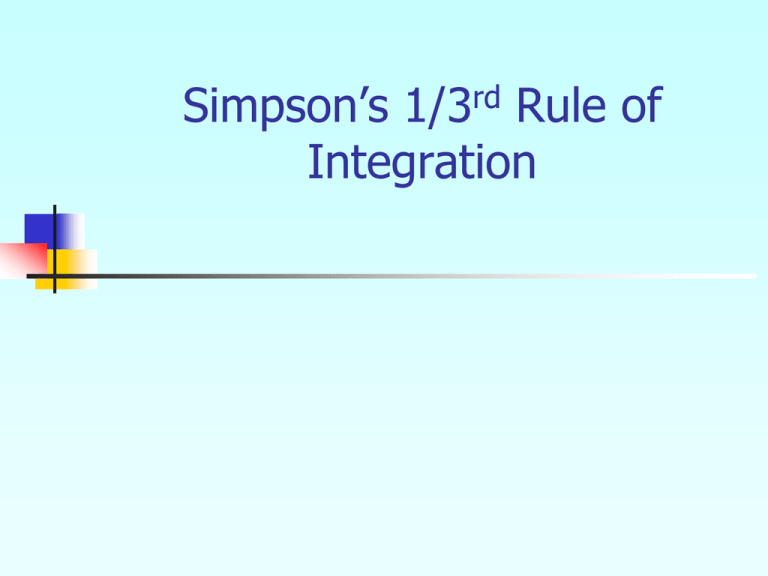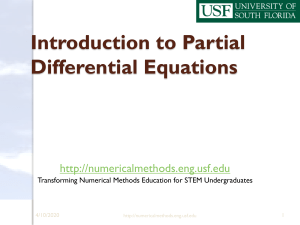Simpson's 1/3rd Rule
advertisement

Simpson’s 1/3rd Rule of Integration What is Integration? b Integration The process of measuring the area under a curve. f ( x )dx y a f(x) b I f ( x )dx a Where: f(x) is the integrand a= lower limit of integration b= upper limit of integration 2 a b x http://numericalmethods.eng.usf.edu Simpson’s 1/3rd Rule 3 http://numericalmethods.eng.usf.edu Basis of Simpson’s 1/3rd Rule Trapezoidal rule was based on approximating the integrand by a first order polynomial, and then integrating the polynomial in the interval of integration. Simpson’s 1/3rd rule is an extension of Trapezoidal rule where the integrand is approximated by a second order polynomial. Hence b b a a I f ( x )dx f 2 ( x )dx Where f2( x ) is a second order polynomial. f 2 ( x ) a0 a1 x a2 x 2 4 http://numericalmethods.eng.usf.edu Basis of Simpson’s 1/3rd Rule Choose a b a b ( a , f ( a )), ,f , 2 2 and ( b , f ( b )) as the three points of the function to evaluate a0, a1 and a2. f ( a ) f 2 ( a ) a 0 a1 a a 2 a 2 a b a b a b a b f f2 a0 a1 a2 2 2 2 2 2 f ( b ) f 2 ( b ) a0 a1b a 2 b 2 5 http://numericalmethods.eng.usf.edu Basis of Simpson’s 1/3rd Rule Solving the previous equations for a0, a1 and a2 give a b 2 a f ( b ) abf ( b ) 4abf abf ( a ) b f ( a ) 2 a0 a 2 2ab b 2 a b a b af ( a ) 4af 3af ( b ) 3bf ( a ) 4bf bf ( b ) 2 2 a1 a 2 2ab b 2 a b 2 f ( a ) 2 f f ( b ) 2 a2 a 2 2ab b 2 2 6 http://numericalmethods.eng.usf.edu Basis of Simpson’s 1/3rd Rule Then b I f 2 ( x )dx a b a0 a1 x a2 x 2 dx a b x x a0 x a1 a 2 2 3 a 2 3 b2 a2 b3 a3 a0 ( b a ) a1 a2 2 3 7 http://numericalmethods.eng.usf.edu Basis of Simpson’s 1/3rd Rule Substituting values of a0, a1, a 2 give b f 2 ( x )dx a ba a b f ( a ) 4 f f ( b ) 6 2 Since for Simpson’s 1/3rd Rule, the interval [a, b] is broken into 2 segments, the segment width h 8 ba 2 http://numericalmethods.eng.usf.edu Basis of Simpson’s 1/3rd Rule Hence h a b f ( x ) dx f ( a ) 4 f f ( b ) 2 3 2 a b Because the above form has 1/3 in its formula, it is called Simpson’s 1/3rd Rule. 9 http://numericalmethods.eng.usf.edu Example 1 The distance covered by a rocket from t=8 to t=30 is given by 140000 x 2000 ln 9 . 8 t dt 140000 2100t 8 30 a) Use Simpson’s 1/3rd Rule to find the approximate value of x b) Find the true error, Et c) Find the absolute relative true error, 10 t http://numericalmethods.eng.usf.edu Solution a) 10 x f ( t )dt 0 b a a b x f ( a ) 4 f f ( b ) 6 2 30 8 f ( 8 ) 4 f ( 19 ) f ( 30 ) 6 22 177.2667 4( 484.7455 ) 901.6740 6 11065.72 m 11 http://numericalmethods.eng.usf.edu Solution (cont) b) The exact value of the above integral is 140000 x 2000 ln 9 . 8 t dt 140000 2100t 8 30 11061.34 m True Error Et 11061.34 11065.72 4.38 m 12 http://numericalmethods.eng.usf.edu Solution (cont) a)c) Absolute relative true error, 11061.34 11065.72 t 100% 11061.34 0.0396% 13 http://numericalmethods.eng.usf.edu Multiple Segment Simpson’s 1/3rd Rule 14 http://numericalmethods.eng.usf.edu Multiple Segment Simpson’s 1/3rd Rule Just like in multiple segment Trapezoidal Rule, one can subdivide the interval [a, b] into n segments and apply Simpson’s 1/3rd Rule repeatedly over every two segments. Note that n needs to be even. Divide interval [a, b] into equal segments, hence the segment width ba h n b xn a x0 f ( x )dx f ( x )dx where x0 a 15 xn b http://numericalmethods.eng.usf.edu Multiple Segment Simpson’s 1/3rd Rule f(x) b x2 x4 x0 x2 f ( x )dx f ( x )dx f ( x )dx ..... a . . . . . xn 2 xn xn 4 xn 2 .... f ( x )dx f ( x )dx x x0 x2 xn-2 xn Apply Simpson’s 1/3rd Rule over each interval, f ( x0 ) 4 f ( x1 ) f ( x2 ) f ( x ) dx ( x x ) ... 2 0 6 a b f ( x2 ) 4 f ( x3 ) f ( x4 ) ( x4 x2 ) ... 6 16 http://numericalmethods.eng.usf.edu Multiple Segment Simpson’s 1/3rd Rule f ( xn4 ) 4 f ( xn3 ) f ( xn2 ) ... ( xn2 xn4 ) ... 6 f ( xn2 ) 4 f ( xn1 ) f ( xn ) ( xn xn2 ) 6 Since xi xi 2 2 h 17 i 2, 4, ..., n http://numericalmethods.eng.usf.edu Multiple Segment Simpson’s 1/3rd Rule Then f ( x0 ) 4 f ( x1 ) f ( x2 ) ... f ( x )dx 2h 6 a b f ( x2 ) 4 f ( x3 ) f ( x4 ) 2h ... 6 f ( xn4 ) 4 f ( xn3 ) f ( xn2 ) 2h ... 6 f ( xn2 ) 4 f ( xn1 ) f ( xn ) 2h 6 18 http://numericalmethods.eng.usf.edu Multiple Segment Simpson’s 1/3rd Rule b h f ( x )dx 3 f ( x0 ) 4 f ( x1 ) f ( x3 ) ... f ( xn1 ) ... a ... 2 f ( x2 ) f ( x4 ) ... f ( xn2 ) f ( xn )}] n 1 n 2 h f ( x 0 ) 4 f ( xi ) 2 f ( xi ) f ( x n ) 3 i 1 i 2 i odd i even n 1 n 2 ba f ( x 0 ) 4 f ( xi ) 2 f ( xi ) f ( x n ) 3n i 1 i 2 i odd i even 19 http://numericalmethods.eng.usf.edu Example 2 Use 4-segment Simpson’s 1/3rd Rule to approximate the distance covered by a rocket from t= 8 to t=30 as given by 140000 x 2000 ln 9 . 8 t dt 140000 2100t 8 30 Use four segment Simpson’s 1/3rd Rule to find the approximate value of x. b) Find the true error,E t for part (a). c) Find the absolute relative true error, a for part (a). a) 20 http://numericalmethods.eng.usf.edu Solution a) Using n segment Simpson’s 1/3rd Rule, 30 8 h 5.5 4 So f (t 0 ) f (8) f (t1 ) f (8 5.5) f (13.5) f (t 2 ) f (13.5 5.5) f (19) f (t 3 ) f (19 5.5) f (24.5) f (t4 ) f (30) 21 http://numericalmethods.eng.usf.edu Solution (cont.) n 1 n 2 ba x f (t 0 ) 4 f (t i ) 2 f (t i ) f (t n ) 3n i 1 i 2 i odd i even 3 2 30 8 f (8) 4 f (t i ) 2 f (t i ) f (30) 3(4) i 1 i 2 i odd i even 22 22 f (8) 4 f (t1 ) 4 f (t 3 ) 2 f (t 2 ) f (30) 12 http://numericalmethods.eng.usf.edu Solution (cont.) cont. 11 f (8) 4 f (13.5) 4 f (24.5) 2 f (19) f (30) 6 11 177.2667 4(320.2469) 4(676.0501) 2(484.7455) 901.6740 6 11061.64 m 23 http://numericalmethods.eng.usf.edu Solution (cont.) b) In this case, the true error is Et 11061.34 11061.64 0.30 m c) The absolute relative true error 11061.34 11061.64 t 100% 11061.34 0.0027% 24 http://numericalmethods.eng.usf.edu Solution (cont.) Table 1: Values of Simpson’s 1/3rd Rule for Example 2 with multiple segments 25 n Approximate Value Et 2 4 6 8 10 11065.72 11061.64 11061.40 11061.35 11061.34 4.38 0.30 0.06 0.01 0.00 |Єt | 0.0396% 0.0027% 0.0005% 0.0001% 0.0000% http://numericalmethods.eng.usf.edu






